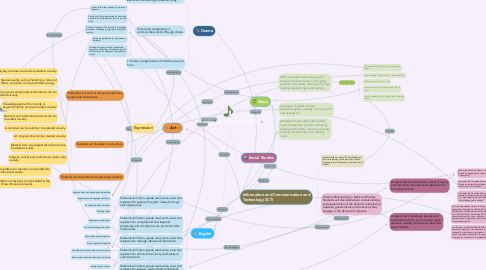
1. Drama
1.1. To acquire knowledge of self and others that results from reflecting on dramatic play.
1.2. To develop competency in communication skills through drama.
1.2.1. Communicate the meaning of a piece of literature.
1.2.2. Develop skills of presentation by becoming aware of the importance of face, voice and body.
1.2.3. Develop language skills through the language processes of speaking, listening, writing and reading.
1.2.4. Develop appreciation for enjoyment of literature.
1.2.5. Develop empathy through experiencing thoughts and feelings of other people and other cultures, as expressed through their stories
1.3. To foster an appreciation for drama as an art form.
2. Art
2.1. Expression
2.1.1. Students will record or document activities, people and discoveries.
2.1.1.1. Everyday activities can be documented visually.
2.1.1.2. Special events, such as field trips, visits and festive occasions can be recorded visually.
2.1.1.3. Family groups and people relationships can be recorded visually.
2.1.1.4. Knowledge gained from study or experimentation can be recorded visually.
2.1.1.5. National and international events can be recorded visually.
2.1.2. Students will illustrate or tell a story.
2.1.2.1. A narrative can be retold or interpreted visually.
2.1.2.2. An original story can be created visually.
2.1.2.3. Material from any subject discipline can be illustrated visually.
2.1.2.4. Slogans, causes and promotions can be told visually.
2.1.3. Students will decorate items personally created.
2.1.3.1. Details, patterns or textures can be added to two-dimensional works.
2.1.3.2. Details, patterns or textures can be added to the surface of three-dimensional works.
3. English
3.1. Students will listen, speak, read, write, view and represent to explore thoughts, ideas, feelings and experiences.
3.1.1. Express ideas and develop understanding
3.1.2. Experiment with language and forms
3.1.3. Consider the ideas of others
3.1.4. Combine ideas
3.2. Students will listen, speak, read, write, view and represent to comprehend and respond personally and critically to oral, print and other media texts.
3.2.1. Experience various texts
3.2.2. Construct meaning from texts
3.3. Students will listen, speak, read, write, view and represent to manage ideas and information.
3.3.1. Share ideas and information
3.3.2. Plan to gather information
3.4. Students will listen, speak, read, write, view and represent to enhance the clarity and artistry of communication.
3.4.1. Use effective oral and visual communication
3.4.2. Demonstrate attentive listening and viewing
3.5. Students will listen, speak, read, write, view and represent to respect, support and collaborate with others.
3.5.1. Relate texts to culture
3.5.2. Celebrate accomplishments and events
4. Music
4.1. Skills: Concepts essentially taught through the participation of singing, playing instruments, listening, moving, reading (and writing) and creating.
4.1.1. Skill: CREATING
4.1.1.1. Use suitable sound effects for poems and songs
4.1.1.2. Create singing "conversations" (tone matching)
4.1.1.3. Make up new words to songs
4.1.1.4. Create movement to demonstrate form in music
4.1.1.5. Create introductions, interludes and codas for songs
4.2. Concepts: Divided into five elements-rhythm, melody, harmony, form and expression.
4.3. Attitudes: Positive attitudes toward music fostered by success in singing, playing instruments, listening, moving, reading (and writing) and creating music.
5. Social Studies
6. Information and Communication and Technology (ICT)
6.1. Students learn and apply ICT knowledge and skills while learning in content areas such as language arts, mathematics, science and social studies.
6.2. Citizens Participating in Decision Making: Students will demonstrate an understanding and appreciation of the dynamic relationship between governments and citizens as they engage in the democratic process.
6.2.1. Analyze how the democratic ideals of equity and fairness have influenced legislation in Canada over time.
6.2.1.1. Why is the Canadian Charter of Rights and Freedoms entrenched in the Canadian Constitution?
6.2.1.2. How does the Canadian Charter of Rights and Freedoms protect the individual rights and freedoms of all Canadians?
6.2.1.3. How does the Canadian Charter of Rights and Freedoms protect collective rights in Canada (i.e., Aboriginal rights, the linguistic rights of official language minorities)?
6.2.2. Analyze how individuals, groups and associations within a community impact decision making of local and provincial governments.
6.2.2.1. How do associations such as the Association canadienne-française de l'Alberta (ACFA), the Métis Nation of Alberta Association (MNAA) and the First Nations Authorities (FNA) provide their members with a voice, at local and provincial levels, exercising historical and constitutional rights?
6.2.2.2. In what ways do elected officials demonstrate their accountability to the electorate (e.g., respond to constituents, participate in local events, represent and express in government meetings the concerns of constituents)?
